Olalla Sáiz Vázquez, occupational therapist and professor at the University of Burgos, presents together with her students Sara Sancho Gutiérrez, Nerea Santamaría Domínguez and Sara Zurera de la Fuente, a cognitive workshop with NeuronUP for the occupational therapy intervention of people with schizophrenia.
What is schizophrenia
The schizophrenia is a serious mental disorder that impacts the way a person thinks, feels and acts. People with this condition may appear to have lost touch with reality, which can be very difficult both for them and for their loved ones (1).
The symptoms of schizophrenia can make participation in daily activities difficult, but there are effective treatments that can make a big difference. With treatment, people with schizophrenia can continue studying, keep their jobs, become independent and enjoy personal relationships (1).
It is essential to identify the symptoms of schizophrenia and seek help quickly. Usually, diagnosis is made between ages 16 and 30, after a first psychotic episode (1).
Starting treatment as soon as possible after this first episode is a key step toward recovery (1).
Symptoms of schizophrenia can vary from person to person, but they are usually grouped into three main categories: psychotic, negative and cognitive symptoms (1).
Symptoms of schizophrenia
1. Psychotic symptoms
A person with psychotic symptoms often experiences distorted perceptions and thoughts, which can make it difficult to distinguish between reality and what is not. In some people, these symptoms come and go, while in others they may stabilize over time.
Psychotic symptoms include hallucinations, delusions and thought disorders (1):
- Hallucinations: a person perceives things that do not actually exist, either through sight, hearing, smell, taste or touch.
- Delusions: a person holds firm beliefs that are not objectively true and that may seem illogical or strange to others.
- Thought disorders: a person has unusual or illogical ways of thinking.
2. Negative symptoms
Negative symptoms include a lack of motivation, loss of interest or pleasure in everyday activities, social withdrawal, difficulty expressing emotions and problems functioning normally (1).
3. Cognitive symptoms
Cognitive symptoms include difficulties paying attention, concentrating and remembering information. These problems can make it hard to follow a conversation, learn new things or remember appointments (1).

Subscribe
to our
Newsletter
Occupational therapy intervention for schizophrenia
Intervention objectives for people with schizophrenia
General objective of the intervention
Improve the impaired cognitive functions in people with schizophrenia through intervention strategies.
Specific objectives of the intervention
- Increase sustained attention and concentration through a cognitive workshop.
- Improve reasoning and problem-solving skills of patients with schizophrenia.
- Develop participants’ social cognition through conducting a workshop.
- Improve patients’ cognitive self-management abilities and coping strategies for people with schizophrenia.
- Promote verbal expression in people with schizophrenia by fostering spontaneous comprehension and coherent word construction.
Approach to intervention for people with schizophrenia
Regarding the intervention, a series of NeuronUP activities will be carried out two days a week and with a duration of 1 hour and 30 minutes.
The order of the exercises is as follows:
- Sorting Bugs
- Match the Cards
- Making Words
- Actions in situations
It will be explained what each activity consists of, which objectives will be addressed and at what level it will start. In addition, a screenshot of each one will be added.
Finally, we highlight that these activities have been chosen for adults with schizophrenia.
1. Sorting Bugs
The game Sorting Bugs consists of sorting the bugs according to the color they have on the right or left side of the screen, depending on where the model bug with its respective color is located. Red bugs are placed on the right side of the screen while green bugs are placed on the left.
It is made up of 12 stages divided into three levels: easy level, medium level and difficult level:
- The easy level consists of the first four stages and you have 60 seconds to complete each of them.
- The medium level consists of stages 5, 6, 7 and 8; of which in the first two you have 90 seconds and in the last two stages you have 120 seconds to complete each of them.
- The difficult level consists of stages 9, 10, 11 and 12, of which in the first two you have 150 seconds and in the last two you have 180 seconds.
Depending on the stage there are fewer or more bugs. That is, as you advance in stages there are more bugs to place, while when you move down stages there are fewer bugs to place.
Once each exercise is completed, you move on to the next one, increasing the difficulty. If you do not complete the exercise, you must repeat it until you manage to complete it. If you fail three exercises, you drop back to the previous stage.
The timer is not visible.
With Sorting Bugs, the objectives to be addressed are the following:
- increase sustained and selective attention,
- and promote processing speed.
The appropriate level to start this activity would be level 4-5, preferably level 4 since there are fewer bugs and the level is easier, which makes the activity more manageable.
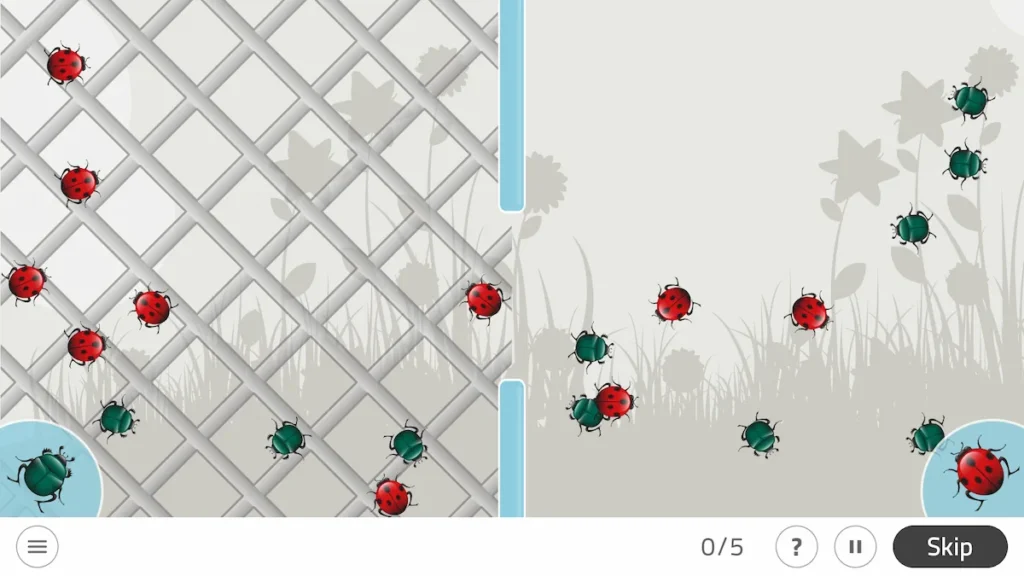
2. Match the Cards
The game Match the Cards consists of pairing cards that have identical images. The player must flip two cards on each turn to see if they are the same. If they are, they remain face-up; if not, they are flipped back over and the player must continue matching cards until all are paired with their identical card.
It is made up of 12 stages divided into three levels: easy level, medium level and difficult level:
- The easy level includes the first four stages (1, 2, 3 and 4).
- The medium level includes stages 5, 6, 7 and 8.
- The difficult level is composed of the last four stages (9, 10, 11 and 12).
Depending on the stage there are fewer or more cards. That is, as the stage increases there are more cards to match, while in lower difficulty stages there are fewer cards to match.
Once each exercise is completed, you move on to the next one, increasing the difficulty. If you do not complete the exercise, you will have to repeat it until you manage to complete it. If you fail three times on the same exercise, you drop to the previous stage.
With Match the Cards the objectives to be addressed are the following:
- increase selective attention and working memory,
- and promote processing speed.
The appropriate level to start this activity would be level 4, so that the person becomes accustomed to the activity and it is neither too easy nor too difficult.
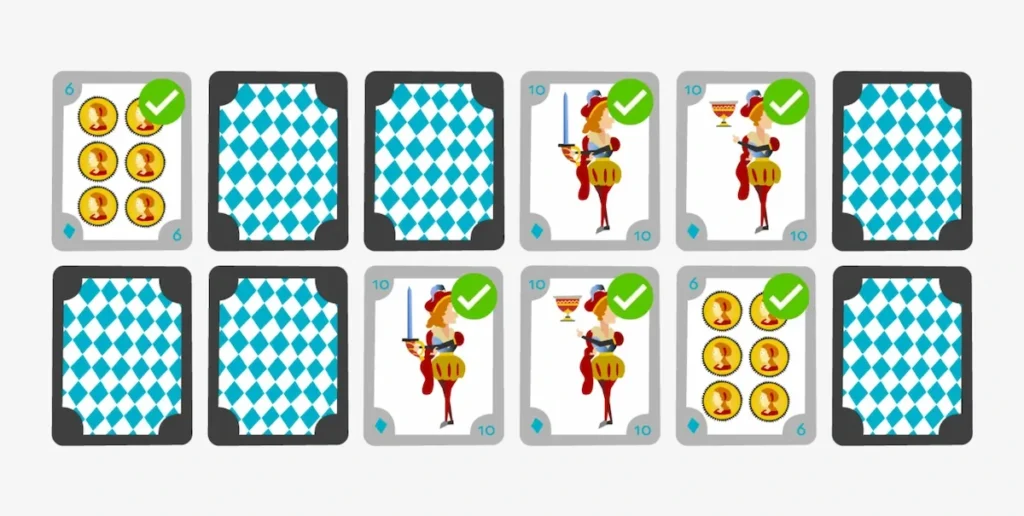
3. Making Words
Making Words consists of forming words by ordering fragments, syllables or individual letters. This game is organized into three levels of difficulty: easy, medium and difficult, allowing some general aspects and parameters to be customized to adjust it to each user’s needs.
The appropriate level to start this activity would be the easy level, since it is the simplest level. Difficulty will be increased as levels are passed.
Making Words is focused on working on working memory, vocabulary and hemispatial neglect. Therefore the objectives to be addressed are the following:
- increase sustained attention and concentration,
- as well as improve reasoning,
- and promote verbal expression in people with schizophrenia by fostering spontaneous comprehension and the construction of coherent words.
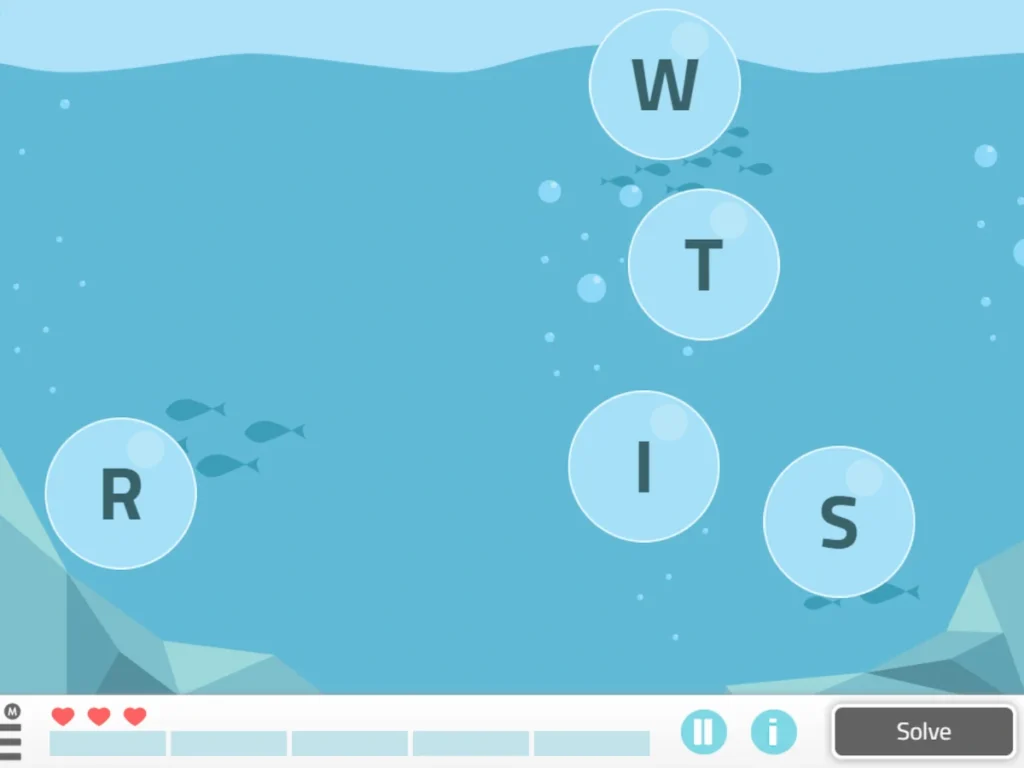
4. Actions in situations
Actions in situations is an activity designed to stimulate cognitive and emotional skills by simulating real-life contexts; as well as deciding how to act in various situations.
It consists of presenting specific scenarios in which participants must assume roles and make decisions to solve problems or handle social situations. With it, players face simulated situations that can be either everyday or challenging, such as handling a workplace conflict…
Scenarios can be described verbally, through cards, or via an interactive interface (in the case of digital applications).
Actions in situations presents four levels of difficulty: basic, intermediate, advanced and expert. It is preferable to start at the basic level and gradually increase the difficulty.
It is focused on working executive functions; such as decision-making and reasoning. Therefore, the objectives to be addressed are the following:
- improve reasoning and problem-solving of patients with schizophrenia,
- develop participants’ social cognition through conducting a workshop,
- and improve patients’ cognitive self-management capacity and coping strategies of patients with schizophrenia.
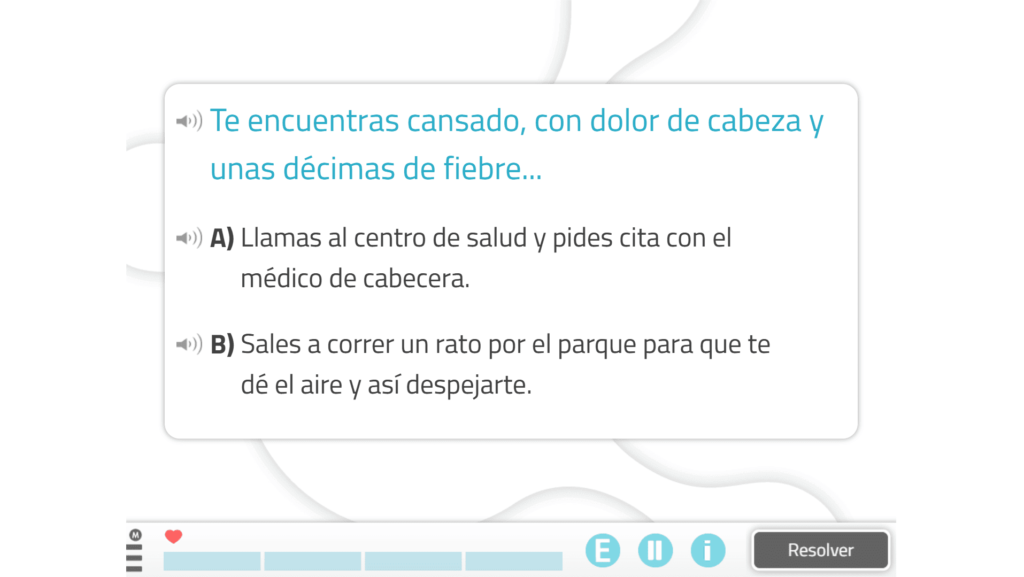
NeuronUP for occupational therapy intervention in schizophrenia
From an occupational therapy perspective, using the application NeuronUP is very beneficial for people who need to improve their cognitive and functional abilities. NeuronUP offers a variety of exercises adjusted to different difficulty levels, which allows personalizing the intervention according to the patient’s needs, whether to optimize memory, attention, executive functions or processing speed. This personalization supports an individualized approach, a fundamental principle in occupational therapy.
By working on essential cognitive skills through interactive games and practical activities, users improve their ability to perform daily tasks more independently, which is one of the main goals of occupational therapy. Continuous cognitive stimulation adapted to each person’s particular needs can have a positive impact on quality of life, helping people maintain their autonomy, participation and performance in daily activities, reducing the risk of cognitive decline.
The platform is easy to use and accessible, allowing people of different ages and with varying levels of technological skills to benefit from it, facilitating its integration into rehabilitation or cognitive stimulation processes, both in therapeutic settings and at home.
In addition, NeuronUP enables detailed monitoring of users’ progress, which facilitates assessing their progress and adapting exercises as their skills improve, which is useful for occupational therapists when adjusting interventions effectively.
Bibliography
- Schizophrenia [Internet]. National Institute of Mental Health (NIMH). [cited 2024 Nov 12]. Available at: https://www.nimh.nih.gov/health/publications/espanol/la-esquizofrenia
If you liked this blog post about a cognitive workshop with NeuronUP for the intervention of schizophrenia, you will likely be interested in these NeuronUP articles:
“This article has been translated. Link to the original article in Spanish:”
Taller cognitivo con NeuronUP para la intervención de la esquizofrenia
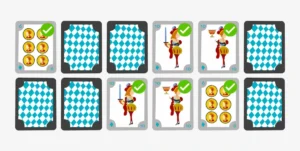
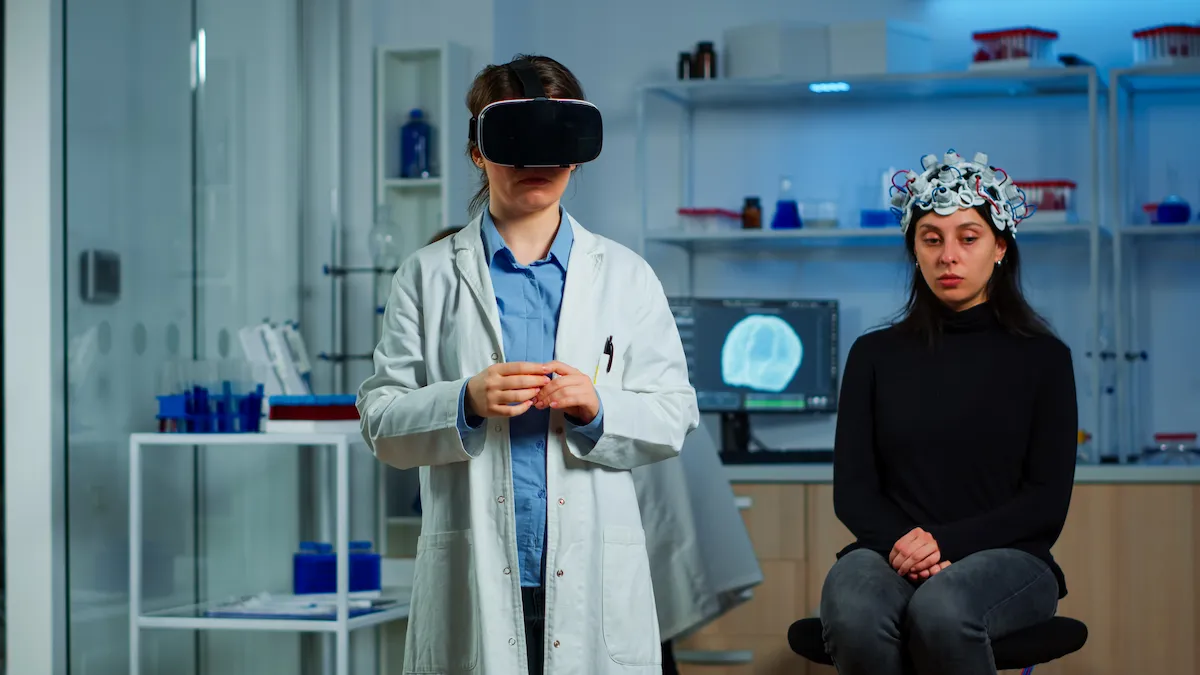

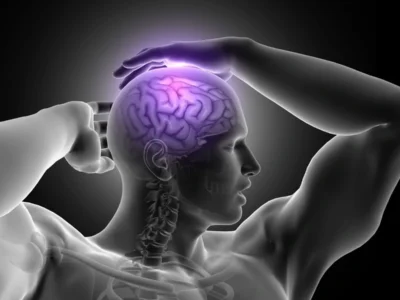
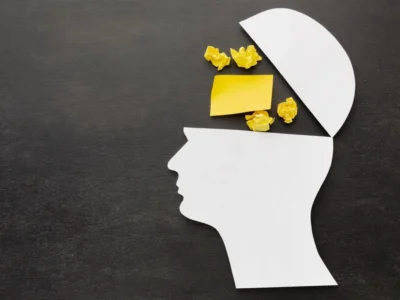
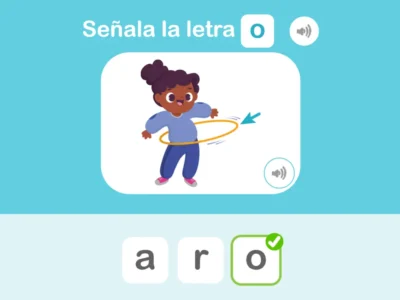
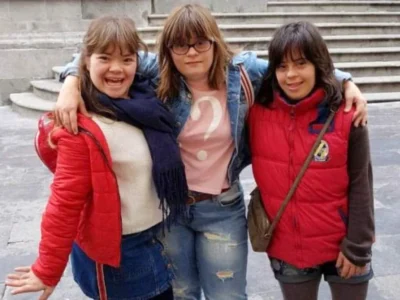
 This Valentine’s Day, discover the benefits of rehabilitation and cognitive stimulation as a couple
This Valentine’s Day, discover the benefits of rehabilitation and cognitive stimulation as a couple
Leave a Reply